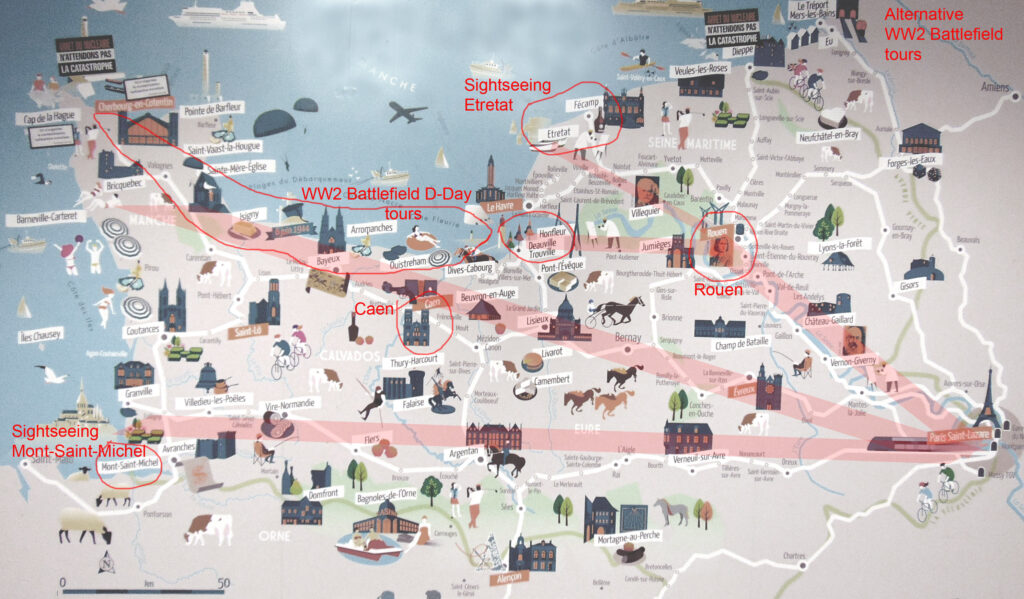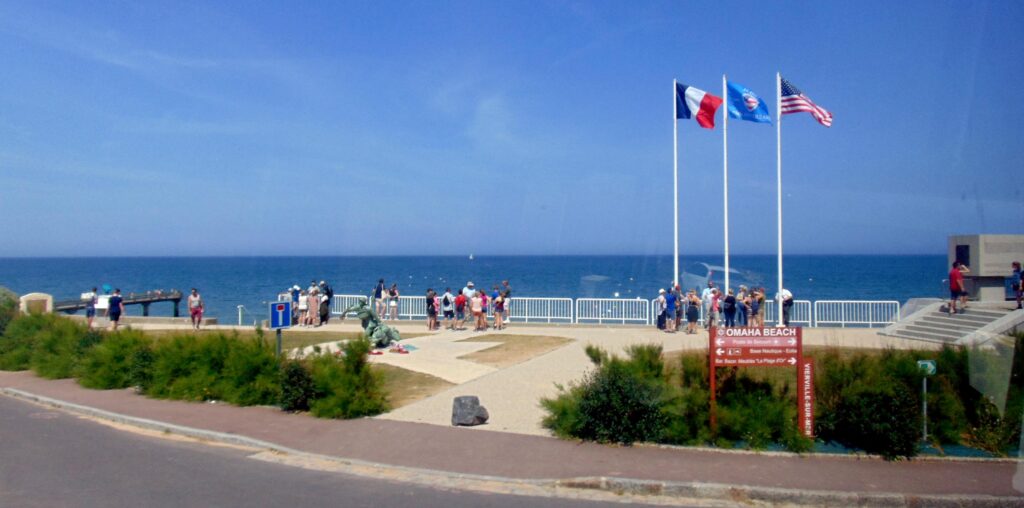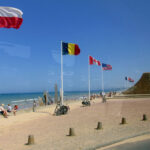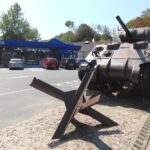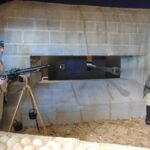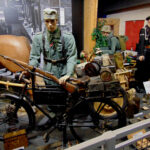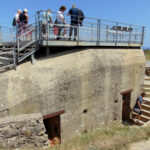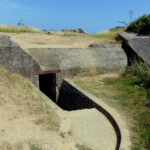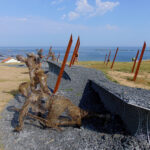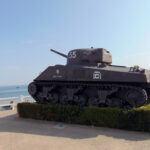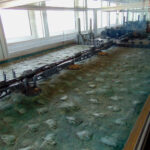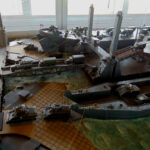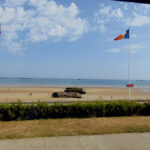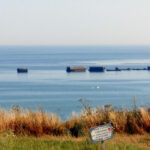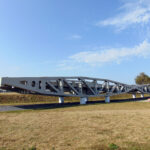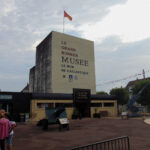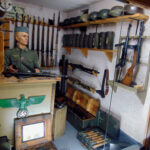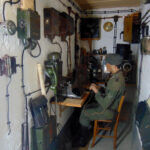The best private tours from Paris by car to Normandy to the WW2 battlefields of the allied landings on D-day on the beaches according to the individual programs and the routes.
Depending on the distance from Paris, the following options are available for D-Day trips to the beaches of Normandy. Private Tours to Normandy from Paris for one day or 2-7 days:
1 Sword beach– the city of Caen with a tour of the fortress-citadel, a visit to the D-Day Museum, a trip to the Grand Bunker of the Atlantic Wall, a bird’s-eye view of the area (Ferris wheel) is possible. Allied landing beach. Lunch in an old town in a cafe in the style of “militaria”. Places of defense of the Germans and the Russian battalion (ROA Cossacks). Visiting the artillery battery and museums in it.
2 Juno-Gold beaches– the ancient city of Bayeux, a museum of the history of the Allied landings in Normandy, a walking tour of the city. Allied landing beaches and construction of an “artificial port”. Magnificent museums and engineering structures, monuments and memorials. Circular panorama. Armored vehicles, tanks, cars…
3 Omaha beach– the city of Bayeux and the museum of the history of the landing of the allies in Normandy, a tour of the city. Places of the unsuccessful landing of American troops (“Bloody Omaha”), where Wehrmacht soldiers and Russian volunteers of the ROA fought desperately with the Cossacks. Excellent museums with military equipment, mannequins, uniforms, everyday life and various militaria. Cape Ok – a system of engineering structures of 6 batteries with underground casemates, which was captured by the Allied special forces. An important and beautiful section of the Atlantic Wall on the headland of the English Channel. With the help of our partner friends, we can organize a local trip here in the legendary World War II jeep.
4 Utah beach– American troops landed here. There are museums and memorials. It is recommended to visit after the above routes. A small reference of leading experts about the event, members of our team, authors of books on this topic.
D day, Allied landings in Normandy 6 June 1944
Operation planning, the balance of power and the preparation see below.
Seizure of bridgeheads.
Utah Beach was located on the western flank of the Anglo-American invasion zone and occupied a sector up to 5 km wide between Puppville and La Madeleine on the left bank of the Duve River estuary. Almost at the scheduled time (6.30), the troops of the 4th Infantry Division of the 7th US Army Corps with attached units began to land at a distance of up to 90 meters from the water’s edge. In the first echelon, there was a landing on 20 boats of 30 people each. Behind him, at intervals of several minutes, followed two battalions, with a total strength of up to 1000 people. each, behind which the last two waves landed with units of engineering troops, artillery and controls. German batteries tried to prevent the landing, but were almost all put out of action by Allied naval artillery fire. By the end of the first day of the landing, the Americans were able to move inland and link up with the 82nd Airborne Division. Their losses in killed and wounded amounted to only 197 people.
Omaha Beach was a narrow coastal strip 8 km long from the eastern edge of Saint-Honorine-de-Perthe to the western edge of Vierville-sur-Mer, on the right bank of the Duve delta. The troops landing here numbered 34 thousand people. from the 1st and 29th Infantry Divisions of the 5th US Army Corps. The main task of the first day of the landing was: on the move to seize the coastal bridgehead between Port-en-Bessin-Huppin and the Vir River, in the future, building on success, connect with the British, who landed on the Gold bridgehead and go to the Isigny area in the west to connect with parts of the 7th Corps at the Utah bridgehead.
Unlike the previous section, the enemy defenses in the landing zone were not sufficiently suppressed, and the landing craft that approached the shore were met by heavy fire from units of the German 352nd Infantry Division, which was on alert in connection with the repulsion exercises that day. landing. Of the 32 tanks launched, 27 sank due to heavy surf, and the artillery units landed late, leaving the infantry and rangers without fire support. Suffering huge losses from enemy artillery and machine-gun fire, the Americans barely captured two small strongholds, thanks to which the remnants of their first echelon entrenched themselves on a small stretch of coastline 1.5-2 km deep. From the surviving troops, battle groups were formed consisting of regiments, battalions and companies, which only two days after the landing were able to complete the task of the first day of the invasion.
American losses during the landing on Omaha Beach amounted to: up to 3,000 people killed and missing, 26 guns, 50 tanks, up to 50 landing ships and boats, and 10 transport ships. Of the 2,400 tons of supplies destined for the landing force, there were only 100 on the shore. The Germans lost up to 1,200 people killed, wounded and missing.
- Omaha Beach Memorial, but here you can swim in the sea
- Omaha Museum, Normandy WW2 D-Day battlefield tours from Paris
- Omaha Museum (D-Day WW2 battlefield tours from Paris to Normandy)
- German cyclist and tank crew man on the coast
- Observation deck on the surroundings and the English Channel (Pointe du Hoc)
- Entrance to the dungeon of the bunkers
Gold Beach between the settlements of Anel and Vers-sur-Mer was attacked by the British 50th Northumbrian Infantry Division, reinforced by units of the 79th Armored Division and the 8th Tank Brigade. The main task in this sector was: to attack from the sea on the move to seize the coast and, without stopping the onslaught, rapidly continue the offensive to the south – to capture Arromanches, and then go to Bayeux, thus cutting off the road along the coast to Caen.
The landing began at 7.20. The first wave of landings suffered losses from enemy fire, which survived after massive fire training, but thanks to a timely decision to immediately begin landing tanks and engineering equipment of the 79th division, the initiative was intercepted, and the British were able to break into the bridgehead on the move. By 16.00 they occupied Amel, by 21.00 Arromanches and reached the outskirts of Bayeux.
Together with the amphibious assault, a commando unit landed near Anel (Nore), with the task of making a 16-kilometer forced march through the territory occupied by the enemy and capturing the Port-en-Bessin-Huppin harbor on the extreme right flank of the Gold beach. Enemy resistance did not allow the harbor to be captured on the move, and it was taken only on the third day of the operation.
- The inhospitable beaches of Gold and Juna
- The legendary Sherman tank at a height near Arromaches
- Huge scale model of an artificial port (Arromaches)
- Continuation, diorama details: tanks, cars, trucks
- The original remains of the port on the shore (beach) and at sea (right)
- former artificial landing port on D-Day
- Bridges for an artificial port and a monument to engineers
Juno Beach was located between the settlements of Courcelles-sur-Mer, Saint-Aubin-sur-Mer, Bernières-sur-Mer. Canadian troops landed here as part of the 3rd Infantry Division with reinforcements, which at this stage of the operation were subordinate to the commander of the British 1st Corps. Faced from the very first minutes of the battle with fierce resistance from the German units, which relied on powerful fortifications, the first wave of landing troops suffered up to 50% losses during the landing. However, the special engineering equipment of the 79th armored division landed on the shore helped the paratroopers in overcoming the most threatened areas and breaking through the first line of defense. Despite significant losses, the Canadians were able to overcome the enemy’s defenses and move away from the coast in the very first hours after the start of the invasion, and the group of tanks reached the line of maximum landing advance, determined on the first day of the operation, but without infantry support was forced to return back. By the end of D-Day, the Canadians were almost completely in control of their foothold, moving much deeper than the Allied forces elsewhere.
Sword beach was a sea coast with a length of 8 km from the settlement. Saint-Aubin-sur-Mer to the river Orne. The troops landing here included the British 3rd Infantry Division with the 27th Independent Tank Brigade, the 1st Special Operations Brigade (reinforced by French commandos) and additional forces, incl. units of the 79th armored division. The main task was to capture the city of Caen – the most important transport communications hub of Normandy. Other main tasks were the capture and retention of the Carpiquet airfield in the vicinity of Caen (18 km from the coast), access to the landing zones of the 6th Airborne Division and the capture of commanding heights near Caen.
The first landing units reached the beach at 7.25. Immediately after the landing, commando units began to carry out the task of reaching the landing areas of the 6th division. The resistance of the units of the German 716th Infantry Division was very weak, and already 45 minutes after the landing, the British troops overcame the enemy’s main line of defense. Before 1300, the main British forces reached the Orne River, where they joined up with the paratroopers holding the commanding heights and bridges across the river. At 1600 they were attacked by 50 tanks from the 21st Panzer Division of the Wehrmacht. By evening, the Germans, having suffered losses as a result of air strikes and faced with fierce resistance from the landing force, withdrew to their original positions. The British infantry quickly captured the coastal strip and by the end of the first day advanced to a depth of 8 km without significant losses. At the same time, the main goal of the first day of the invasion – the city of Caen remained in the hands of the enemy.
- Big Bunker of the Atlantic Wall (Oustreham)
- Inside the Big Bunker, armory
- Communications hub, the telegraph and the map of Normandy coast
The results of the operation. During D-Day, the Allies landed in Normandy 5 infantry divisions, 3 airborne divisions and a tank brigade totaling 156,000 men. The American component numbered 73,000 people: 23,250 on Utah Beach, 34,250 on Omaha Beach, and 15,500 airborne. 83,115 soldiers and officers (of which 61,715 were British) landed on the British and Canadian bridgeheads: 24,970 on Gold Beach, 21,400 on Juno Beach, 28,845 on Sword Beach and 7,900 airborne. They managed to capture the coastal strip with a depth of 3 to 5 km, although not along the entire front. The operation involved 11,590 aircraft of various types, flying a total of 14,674 sorties; 127 combat aircraft were shot down. For the landing of an airborne assault during June 6, 2,395 aircraft and 867 gliders were involved. The naval forces involved 6,939 ships and vessels: 1,213 combat, 4,126 landing, 736 auxiliary and 864 merchant ships.
The total losses of the Anglo-American troops during the landing (killed, wounded, missing, captured) amounted to over 10,200 people. (6600 Americans, 2700 British, 946 Canadians). Of these, 4500 people died. (including 2500 Americans).
Wehrmacht troops lost according to available estimates from 4,000 to 9,000 people.
French civilian casualties (mostly from Allied air bombardment) ranged from 15,000 to 20,000.
The strategic importance of the operation. The Normandy landing operation, in terms of the number of forces and means involved, was the largest operation in World War II and in general in the world history of wars. Its most important feature is its huge scale, the large number of troops landed and the forces put into action at sea and in the air, which were determined by the purpose of the operation – to create an independent front of struggle in Western Europe, which was an important factor in the military operations of the anti-Hitler coalition at the final stage of the war against Germany. and her allies. According to the general plan of Operation Overlord, the first stage of the invasion – Operation Neptune as a whole was successfully completed. The bridgehead captured during the operation was half that which was supposed to be taken in accordance with the plan, however, in conditions of absolute air supremacy, it turned out to be possible to concentrate enough forces and means on it for a further strategic offensive operation in North-West France.
**
A trip to the beaches of the Allied landings can be combined with a sightseeing tour of Normandy, including the walled city of Caen and the abbey of Mont Saint-Michel. View the private sightseeing trips to Normandy from Paris or airport (Charles de Gaulle, Orly and Beauvais)
Preparation of the operation, the forces of the parties, the beginning.
The amphibious landing operation of the armed forces of the United States, Great Britain, Canada and their allies, codenamed “Neptune”, was the first stage of Operation Overlord, which provided for the creation of a foothold by the allies in northwestern France for a subsequent offensive with the aim of completely and finally defeating Nazi Germany and liberating from the German occupation of Western Europe. During the development of the plan for the landing operation, Normandy was chosen as the landing area, primarily because of its proximity to the British coast, which made it possible to ensure permanent air supremacy in the landing zone of the allied air forces based on airfields in southern England. Two other options – Brittany and Pas de Calais – were rejected, the first because of the greater distance from naval and air bases, the second – because the German command, considering it as a priority from the point of view of a possible invasion, created a more deeply echeloned defense here. The problem of the lack of convenient ports in Normandy was supposed to be solved by using prefabricated artificial harbors “Mulberry” until Cherbourg and Le Havre were captured by the Allies.
A high tide period was set as the start time for the landings, so that the landing craft would not run aground and suffer damage from German underwater barriers. Since the peak of the tide on different parts of the coast came at different times, each of the four planned bridgeheads had its own start time for landings with a maximum interval of 85 minutes. The start of the operation was originally planned for May 1944, but due to changes made to the plan (the landing of another, fifth, landing force on the Cotentin Peninsula), the date of the invasion was postponed to early June. The high tide that began on June 5 was accompanied by strong winds, which cast doubt on the landing, but the forecast for a short-term improvement in the weather on June 6 influenced the decision of the commander-in-chief of the Allied Expeditionary Force, General Eisenhower, to begin the operation on that very day, which went down in history as D-Day.
Planning of the operation and the forces of the opposing sides
The finally approved plan for Operation Neptune determined the simultaneous landing of large amphibious assault forces on the Normandy coast at a front of up to 80 km. American troops were to land in the western sector in two bridgeheads (Utah and Omaha), British and Canadian troops in the eastern sector in three sites (Gold, Juno and Sword). During the operation, it was planned to capture a bridgehead with a depth of 18-20 km and firmly gain a foothold on it. In the future, the task was to accumulate significant invasion forces, and, having created a significant superiority in forces, to occupy the ports of Cherbourg and Le Havre located on the flanks of the invasion zone with powerful blows. In the future, it was planned to organize a full-scale offensive deep into France. The British, acting in conjunction with Canadian troops, were to capture on the very first day the key objects – the cities of Bayeux and Caen, and advance as far south and southeast as possible. Thus, having mastered the most important transport hubs, the British cut off the approach of German reserves to the Cotentin Peninsula and provided an opportunity for the Americans, acting on the right flank, to gain a foothold in their bridgeheads in order to begin achieving their main goal – the capture of the port of Cherbourg.
In order to achieve the surprise of the invasion, the allied command widely used measures to misinform the enemy in order to mislead him about the time and area of the operation. The Allies strongly supported and spread rumors that the Calais-Boulogne region would be the most likely invasion area. Their aviation delivered massive strikes against antiamphibious defense systems in this particular area, intensifying the strikes immediately before the landing itself (May 30 – June 5). Various means were used for misinformation: radio, the press (both own and neutral countries), the construction of false mock-ups of landing areas, the construction of entire towns and special airfields that could mislead German aerial or undercover intelligence. Numerous demonstrative exits of forces to the sea were widely practiced. Various sources focused the attention of the enemy on the same landing area – Calais – Boulogne.
All measures of disinformation, disorientation and disguise have given the desired result. Until June 6, the German command concentrated almost the entire 15th Army, previously scattered along the coast, in the Calais – Boulogne area. Even when the landing in Normandy began, the Germans believed that this was just a large-scale demonstration, and the commander-in-chief of the Wehrmacht troops in the West, Field Marshal von Rundstedt, for a long time did not dare to redeploy large forces to the landing areas to defeat the landing as soon as possible. Thanks to this, the Allies were able to achieve a huge advantage in forces and equipment in the landing areas on the first and decisive day of the invasion. Only 10 days later, on June 16, 1944, Hitler gave the order to transfer to Normandy from the Eastern Front the 2nd SS Panzer Corps, as well as the 86th Army Corps from Southern France and formations from the 15th Army, which covered the Calais sector – Boulogne from a non-existent threat of invasion. However, these reinforcements arrived at the Normandy front weakened, without the necessary supply of fuel and ammunition, and disorganized as a result of Allied air strikes, which did not allow them to turn the tide in their favor.
In preparation for the invasion of Normandy, the Allies formed the 21st Army Group under the command of the British General Montgomery (2nd British, 1st Canadian and 1st American armies) consisting of 19 infantry, 9 armored and 4 airborne divisions, as well as 3 infantry, 8 armored and 1 parachute brigades. The plan provided for the simultaneous landing of five infantry divisions with reinforcement units (130,000 men and 20,000 vehicles) in five sections of the coast and three airborne divisions in depth. The captured tactical bridgeheads were to be united on the very first day into one common operational bridgehead, and then, having pinned down the enemy in the area of the city of Kan, by the actions of the landing troops on the right flank, launch an offensive to the south and east. All 37 divisions were to be transferred to France within 7 weeks.
Directly in the landing area, the allies were confronted by 5 infantry and 1 airborne divisions, a mobile brigade (scooters) and a separate tank battalion, equipped with captured French vehicles, which were part of the 7th German army, Colonel-General Dolman. To them should be added 1 tank division (21st), which was the only mobile reserve of the army commander, which could be used to repel the landing on the first day of the invasion. Most of the infantry divisions were stationary formations, staffed with personnel who were limitedly fit for military service for medical reasons, and included eastern battalions from former Soviet prisoners of war, which were not distinguished by reliability. There were few divisions whose personnel had combat experience gained on the Eastern Front (such as the 352nd Infantry).
At the end of May 1944, the concentration of the invasion forces in the initial areas was completed. On May 30, the loading of troops and equipment onto ships began, which was completed by June 3. On the morning of June 5, the landing detachments went to sea and before dark reached the control area, from where the transition continued already at night without the cover of fighter aircraft. The passage by sea was carried out by five columns (according to the number of bridgeheads) in conditions of complete radio silence and took place almost in the absence of any opposition from the enemy.
From 22.35 on June 5, Allied aircraft began to strike at the landing areas. 2000 Allied bombers bombarded the coast of Normandy. In total, six massive air raids were carried out and more than 7 thousand tons of bombs were dropped. As a result of these strikes, the German defenses suffered minor damage, but the massive bombardment forced the Germans to hide in shelters, which facilitated the landing of airborne assault forces.
Airborne landing. From 1.30 to 2.30 in the planned landing areas, the largest airborne assault in history was carried out. The landing was accompanied by a force of 2,395 aircraft and 847 gliders. In total, 24,424 paratroopers were landed behind enemy lines and 567 vehicles, 362 guns, 18 tanks, 360 tons of cargo were delivered, of which 60% of the troops were dropped by parachutes, the rest were delivered by gliders. The US 101st and 82nd Airborne Divisions landed 10-15 km from the coast at the base of the Cotentin Peninsula. The British 6th Airborne Division was tasked with seizing a bridgehead between the Orne River and the Caen Canal halfway from Caen to the coast in order to cover the eastern flank of the invading force. At the same time, in order to mislead the enemy about the direction of the main attack, auxiliary landing forces were landed in Brittany, in the Pas de Calais region and in other regions of France with up to 530 French paratroopers from the British Special Airborne Service (SAS).
Despite the difficulties and mistakes that took place during the landing of airborne assault forces and in the course of their operations on the ground (large non-combat losses – almost 35% of the total number of troops landed, slow collection in certain areas, shortcomings in the organization of interaction, which led to a blow to their the same aviation for the English airborne assault), the airborne assaults rendered great assistance to the amphibious assault in landing and seizing bridgeheads. The landing units scattered over a large area, combined with the landing of dummies during disinformation operations, led the enemy into confusion. As a result, the command of the Wehrmacht received conflicting data on the landing of troops along the entire Normandy coast and could not timely and accurately determine the true direction of the main attack.
The two American airborne divisions that were planned to land in the rear zone of the Utah beachhead were to capture key bridges, road junctions, dams, beach exits and other important objects that were supposed to affect the success of the amphibious landing and create the prerequisites for subsequent offensive and capture of Brest. From 0.48 to 1.40 three regiments of the 101st Airborne Division landed in the first wave in the planned area, in the interval from 1.51 to 2.42 they were followed by units of the 82nd Airborne Division. The next two waves of gliders, which landed before dawn, provided the landing force with anti-tank artillery. On the evening of June 6, two more echelons of gliders with artillery, vehicles and cargo were additionally landed. Landed from the air in the area Carentan-Isigny 101st and on both banks of the Merder River west of Sainte-Mer-Eglise, located on the key transport artery of northern Normandy – the Carentan-Cherbourg highway, the 82nd American airborne divisions turned out to be very dispersed over a wide area. 24 hours after the landing, only 2,500 soldiers of the 101st and 2,000 troops of the 82nd division were able to begin their tasks. They managed to capture several settlements, road junctions and bridges that connected the Normandy bridgehead with the rest of France. American paratroopers also captured the city of Saint-Mer-Eglise, which became the first French city liberated from the German invaders. The tasks of the paratroopers of the 6th British Airborne Division included the capture of the bridges at Benouville – Ranville, the destruction of the German coastal battery in Merville, which threatened the Sword bridgehead, the destruction of 5 bridges across the Dev River and the retention of the captured key communications from enemy counterattacks from the east before the approach of the main forces of the amphibious assault. Immediately after landing in the area of the city of Kan, the landing force entered into battle with units of the German 716th Infantry Division. Encountering relatively weak opposition, the British quickly captured crossings over the Orne River and entrenched themselves on these lines. At dawn, the advanced units of the 21st Panzer Division of the Wehrmacht tried to break through the positions of the paratroopers and counterattack on the flank of the British amphibious assault on the Sword bridgehead, but they could not break through their defenses and after a long battle, with heavy losses for both sides, the Germans retreated. By the end of D-Day, the British paratroopers had successfully completed all the tasks assigned to them.
Artillery and air preparation for the landing. From 05:20, artillery support ships that arrived in their assigned areas opened fire from main battery guns at enemy coastal targets. At 7 o’clock in the morning, a formation of American B-29 strategic bombers dropped about 100,000 40-kilogram bombs on the front line of defense in the bridgehead areas. Before dawn, medium bombers entered the battle, the strikes of which were combined with the continuous shelling of the coast by naval artillery. Half an hour after dawn, the coastal installations were hit by the next wave of heavy and medium bombers, which dropped 7,616 bombs. As a result of the fire of artillery support ships and the actions of bomber aircraft, all the main German stationary batteries between the mouth of the Seine and Barfleur were suppressed, although temporarily, and only mobile batteries located in the forest were fired at the ships.
When the batteries of large and medium caliber fell silent, the second stage of artillery support began – ensuring the landing of the first waves of troops. Cruiser artillery came into action, destroying underground structures and firing points of the Germans. Up to 70 destroyers and a large number of special self-propelled barges armed with artillery pieces and multiple launch rocket launchers participated in the suppression of antiamphibious defense means. Under cover of fire from the ships, the landing craft approached their landing sites.
(a brief note was prepared by Ph.D. Drobyazko S.)

